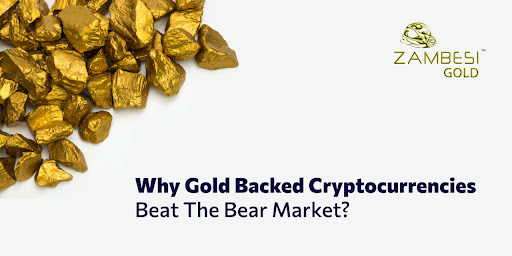Why Gold-Backed Cryptocurrencies Beat The Bear Market
Disclaimer: The text below is an advertorial article that is not part of Cryptonews.com editorial content.

In June 2022, the global cryptocurrency market cap fell below USD 1 trillion for the first time since January 2021. With Bitcoin trading at a 65% decline from its all-time high of USD 69,000 in November, the largest cryptocurrency by market value crashed for 12 consecutive weeks—a groundbreaking downturn for the digital asset.
Closely following, the second-largest cryptocurrency, Ether, was trading below USD 1,300 at around USD 1,235, a decline of 74% from its all-time high of USD 4,878. Neither of the cryptocurrencies has witnessed such crashes since December 2020.
The cryptocurrency winter ensued after the Bureau of Labor Statistics released monthly inflation data from the consumer price index (CPI), indicating an 8.6% year-over-year increase in May, a level way above estimates from Wall Street.
In these uncertain market conditions, investors seek solutions to hedge against inflation. For many past economic downturns and bear markets, gold has proven to be a safe haven for investors worldwide. As a result, many traders and investors choose to invest in gold to protect their capital against value depreciation, which occurs from inflation, causing an increase in general prices.
Since gold prices are related to the value of the US dollar due to gold being dollar-denominated, a stronger USD keeps the price of gold down and more controlled, meaning more gold can be purchased when the dollar is weaker. This protects investors against economic events like currency devaluation and provides a safety net during periods of political instability.
Despite its utility, investors should be aware that many gold mining companies are unsuccessful due to high overhead costs, debt, finance, lack of control over commodity prices, and non-compliance. Investors looking to get into gold-backed cryptocurrencies sometimes fail because they cannot create commercial value nor maintain it.
One company trying to provide a solution for this problem is Zambesi Gold, a thriving business that aims to lead the transition in mining assets becoming fully backed digital assets. Self-described in its whitepaper as being “backed by real gold, real people, and real mining operations combined with real value,” the company believes that current issues in gold investing exist due to companies having “a lack of a business plan which leads to less interest and productivity.”
To solve these problems, an agreement between the Zambesi Token and its investors ensures that no fractional lending will occur. “The number of tokens will be fixed, preventing inflation; therefore, a token’s value will increase irrespective of the demand for the token or the gold price, and the amount of gold backing for each token will increase each month.”
Zambesi believes that each asset should contribute to the profitability of a business and not subsidize other assets to reduce the cost of debt. It allows token holders to be the beneficiaries of the Gold Custodian Trust, a vault where physical bullion gets stored. Since being listed on May 12th, ZGD coin has had a 500% sustainable gain and has never traded at the launching price.
In today’s bear market, investors constantly look for ways to hedge their portfolios against inflation. While gold has been proven to be a safe haven for investors, it is still not without risk, and many investments can take long periods to provide gains. Therefore, instead of traditional methods of investing in gold, investors can look towards gold-backed cryptocurrencies like Zambesi for an even more reliable and secure way to invest in the safeguarded asset.
To learn more about this exciting new project, head to Zambesi Gold’s website today.



